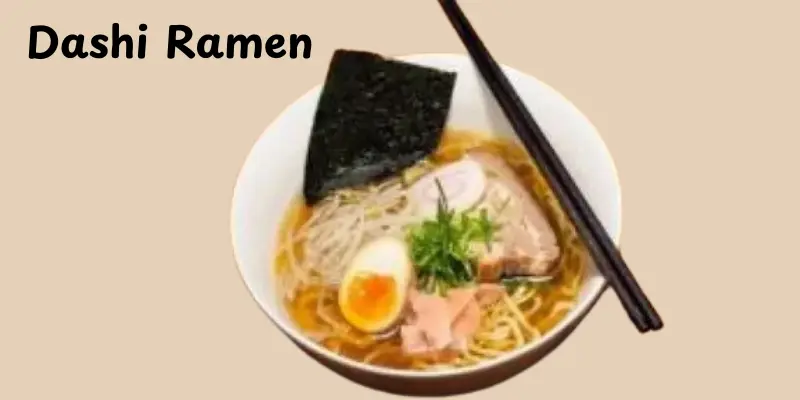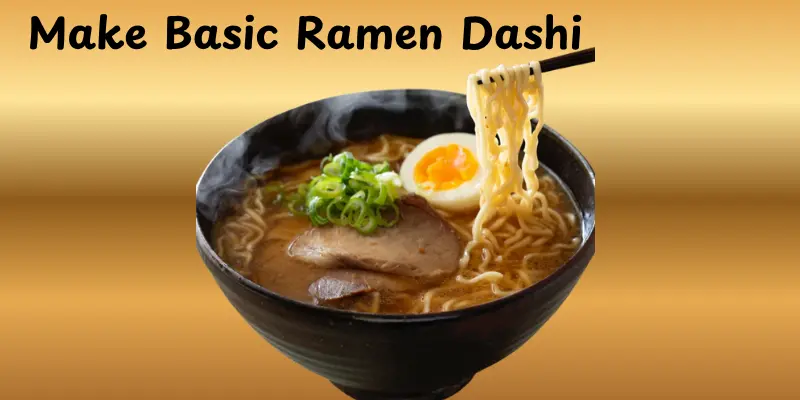Dashi Ramen Explained: Ingredients, Steps, and Tips You’ll Love
Published: 13 Oct 2025
Did you know that the secret behind ramen’s rich and comforting taste is something called Ramen Dashi?It is a Japanese broth made with ingredients like seaweed, bonito flakes, and mushrooms. This flavorful base gives ramen its rich umami flavor, which keeps you drinking until the last drop. In this guide, you’ll learn what dashi is, how it’s made, and how it brings life to every bowl of ramen.
What Is Dashi Ramen?
Dashi Ramen is a Japanese noodle soup made from a delicious broth called dashi. This broth serves as the soup’s base and gives ramen with its rich, delicious umami flavor. It is often prepared by cooking ingredients like seaweed, dried fish, or mushrooms to provide the light but rich taste that defines classic ramen.

Dashi has been used in Japan for hundreds of years and is the basis of Japanese cuisine. Dashi, like chicken broth, provides flavor to common soups and ramen; it creates a thick, flavorful base that makes each bowl taste complete and enjoyable.
Main Types of Dashi Ramen
There are different types of Dashi Ramen, each made with a unique broth that gives a special flavor and texture. Let’s look at the most common ones.
- Traditional Dashi Ramen
- Chicken Dashi Ramen
- Vegan or Vegetable Dashi Ramen
- Fusion Dashi Ramen
Traditional Dashi Ramen
Traditional Dashi Ramen is cooked with a basic but tasty broth of kombu (sea kelp) and bonito flakes (dried fish). This combination produces a clean, savory flavor that defines traditional Japanese ramen. It’s light, full of umami, and commonly used in Shoyu (soy sauce) and Shio (salt-based) ramen.
Chicken Dashi Ramen
Chicken Dashi Ramen is made by boiling chicken bones, garlic, and ginger in a warm, flavorful broth. It has a deep, spicy taste that makes each bite enjoyable. This type of ramen is perfect for people who like a deeper, meatier flavor than traditional dashi.
Vegan or Vegetarian Dashi Ramen
Vegan or Vegetable Dashi Ramen is made without any fish or meat. Instead, it uses dried shiitake mushrooms, kombu (sea kelp), and fresh vegetables to create a rich umami flavor. This ramen is light, healthy, and perfect for plant-based eaters who still want a deep, comforting taste.
Fusion Dashi Ramen
Fusion Dashi Ramen mixes traditional Japanese tastes with global ingredients to create something unique and exciting. Dashi broth is frequently combined with ingredients such as coconut milk, herbs, or spices to create a creamy or sweet flavor. This technique is popular among home cooks who enjoy experimenting with flavors while keeping the essence of ramen alive.
Key Ingredients You Need
To make a delicious bowl of Dashi Ramen, you only need a few simple ingredients. Each one adds its own flavor and helps build that rich, comforting umami taste.
- Kombu (sea kelp): Adds deep umami flavor and a light ocean taste.
- Bonito flakes (fish flakes): Give a smoky, savory touch to the broth.
- Dried shiitake mushrooms: Add a natural, earthy flavor perfect for vegan ramen.
- Water (always clean and cold): The base that brings everything together.
- Optional ingredients: Soy sauce, mirin, miso, or salt for extra flavor and balance.
How to Make Basic Ramen Dashi (Step-by-Step)

Making basic ramen dashi is easy and relaxing. It’s all about letting simple ingredients release deep, rich umami flavors slowly ,just like brewing a perfect cup of tea.
- Soak a piece of kombu (sea kelp) in cold water for about 30 minutes.
- Heat the water slowly until small bubbles appear — do not boil.
- Remove the kombu before the water boils to avoid bitterness.
- Add a handful of bonito flakes or dried mushrooms to the hot water.
- Let it steep for 5–10 minutes, then strain the broth.
- Your dashi is ready to use as a ramen base or to store for later.
How to Use Dashi in Ramen
Dashi is the flavorful heart of ramen, giving each bowl its rich and comforting taste. Once your dashi is ready, you can use it as the base for many ramen styles and customize it with your favorite toppings.
- Shoyu Ramen: Add soy sauce for a savory, balanced flavor.
- Miso Ramen: Mix in miso paste for a deep, nutty taste.
- Shio Ramen: Keep it simple with salt, creating a light, clear broth.
- Toppings: Add ramen noodles, soft-boiled eggs, green onions, and seaweed for extra texture and taste.
Common Mistakes to Avoid
Even a simple broth like dashi can go wrong if you miss a few key steps. Here are the most common mistakes people make when preparing ramen dashi and how to avoid them.
- Boiling kombu too long – this makes your broth bitter.
- Using too much bonito or mushroom – too much can overpower the flavor.
- Not straining properly – leaves unwanted bits and makes the broth cloudy.
- Skipping the soaking time – results in a weaker, less flavorful broth.
Tips for Perfect Dashi
A great bowl of ramen starts with a perfectly balanced dashi. With a few simple tricks, you can bring out the best umami flavor and make your broth taste rich yet clean every time.
- Use cold, filtered water to get a pure, clear taste.
- Never boil kombu; gentle heat keeps the flavor smooth.
- Use fresh bonito flakes or mushrooms for a stronger aroma.
- Taste as you cook and adjust the salt or soy sauce slowly.
- Store dashi in the fridge for up to 3 days or freeze it for longer use.
Nutrition & Dietary Considerations
Dashi isn’t just flavorful, it’s also light, healthy, and full of nutrients. Whether you prefer a traditional or vegan version, dashi can easily fit into most diets while adding a deep umami taste to your ramen.
- Low in calories: Great for those watching their weight.
- Rich in minerals: Kombu adds iodine and calcium for health benefits.
- High in protein: Bonito flakes provide a gentle protein boost.
- Vegan-friendly option: Use mushrooms and seaweed instead of fish.
- Low fat and gluten-free: Ideal for clean, balanced meals.
Conclusion
So, in this article, we’ve looked over dashi ramen in detail. If you enjoy ramen as much as I do, I highly recommend trying homemade dashi; it makes a major difference in flavor and quality. Starting with a simple kombu and bonito base then taste the magic in every sip. Don’t just read about it; get your ingredients and create your own bowl now!
FAQs
Ramen dashi usually includes kombu (sea kelp), bonito flakes, and water. Some versions add shiitake mushrooms, soy sauce, or miso for extra flavor and depth.
Traditional dashi is made from kombu and katsuobushi (dried fish flakes). Vegan versions often use mushrooms or seaweed to create the same rich umami taste.
Dashi ramen has a savory, umami-rich flavor that’s both light and comforting. It blends the ocean’s natural taste with warmth and depth, making every sip satisfying.
Dashi is a simple Japanese soup base made from seaweed and fish flakes. Ramen broth is richer and often includes dashi plus other ingredients like meat or soy sauce for deeper flavor.
Yes, you can! Use dried shiitake mushrooms or other seaweeds as substitutes for a light umami flavor. It won’t taste exactly the same but still works well for ramen.
Keep dashi in the fridge for 2–3 days or freeze for up to 2 weeks in an airtight container. Always reheat gently before use.
Yes, instant dashi cubes are convenient and quick to use. However, homemade dashi has a cleaner and fresher taste that’s hard to beat.
Traditional dashi isn’t vegan because it uses bonito flakes, but vegan versions made with mushrooms and kombu are popular. It’s naturally gluten-free unless you add soy sauce with gluten.

- Be Respectful
- Stay Relevant
- Stay Positive
- True Feedback
- Encourage Discussion
- Avoid Spamming
- No Fake News
- Don't Copy-Paste
- No Personal Attacks

- Be Respectful
- Stay Relevant
- Stay Positive
- True Feedback
- Encourage Discussion
- Avoid Spamming
- No Fake News
- Don't Copy-Paste
- No Personal Attacks





